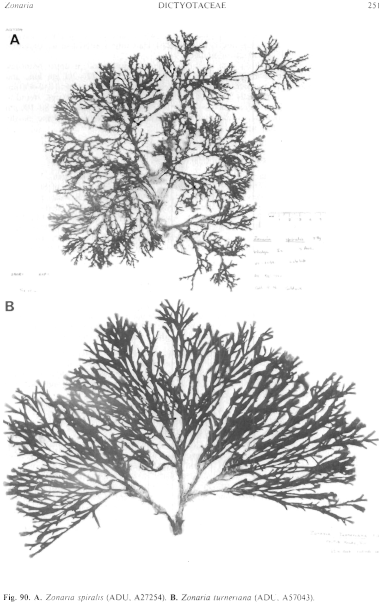|
|
|
|
|
|||||||||||
|
Electronic Flora of South Australia Species Fact Sheet
Phylum Phaeophyta – Order Dictyotales – Family Dictyotaceae – Tribe Zonarieae
Selected citations: Womersley 1967: 227.
Synonym
Homoeostrichus spiralis J. Agardh 1894b: 89.
Thallus (Fig. 90A) dark brown, 3–15 (–22) cm long, much branched, with spirally twisted branches above, axes and lower branches complanate and stupose, 1–5 (–9) mm broad, arising from a matted rhizoidal holdfast 3–10 (–20) mm across and 5–10 mm long; epilithic. Fronds irregularly laterally branched with frequent short spinous laterals, regularly twisted, mostly spirally (Fig. 91A) at least in their upper parts, 1–2 (–3) mm broad throughout, with faint concentric growth or hair zones and often with darker central cells forming a slight midrib in surface view. Structure (Fig. 91C) 8 (–10) cells and (120–) 160–200 µm thick throughout, with cells in regular rows in transverse section and cortical cells usually mostly (occasionally less than half) paired (Fig. 91B) with (2–) 3–4 cortical cells to each medullary cell lengthwise; cortical cells (when paired) 6–10 µm across and L/B 1.5–2 (–2.5). Hair tufts scattered or in concentric lines, hairs phaeophycean, 14–18 µm in diameter.
Reproduction: Sori (Fig. 91A) with sporangia amongst paraphyses on upper branches, indusiate early then lost; sporangia (Fig. 91C) ovoid to pyriform, 120–200 µm long and 80–100 µm in diameter, with 8 spores, without a stalk cell; paraphyses 6–10 cells and 250–450 µm long, clavate with ovoid upper cells 25–40 µm in diameter. Oogonial sori scattered, round to irregularly ovate, I 00–500 (–1000) pm across; oogonia clavate, with a stalk cell, 80–100 µm long and 30–40 pm in diameter. Antheridial sori reddish brown, irregular in shape, mostly 0.5–2 mm long and 0.5–1 mm across.
Type from Eucla, W. Aust.; in Herb. Agardh, LD, 48154.
Selected specimens: Belinda Beach, Goose I. Bay, Middle I., Recherche Arch., W. Aust., upper sublittoral in crevice (Trudgen, 17.xi.1973; ADU, A51686). Egg I., Isles of St Francis, S. Aust., 32–38 m deep (Shepherd, 11.i.1971; ADU, A38038). Venus Bay, S. Aust., reef pools (Womersley, 17.i.1951; ADU, A15154, female). Wedge I., S. Aust., 8–10 m deep (Baldock, 29.xii.1963; ADU, A27254). Pondalowie Bay, S. Aust., 2–4 m deep (Womersley, 14.ii.1981; ADU, A57082). Pennington Bay, Kangaroo I., S. Aust., drift (Womersley, 4.i.1948; ADU, A6645, male and A6646, female). Yilki, Victor Harbor, S. Aust., drift ( Womersley, 10.v.1986; ADU, A57110). Flinders, Vic., upper sublittoral ( Womersley, 18.i.1967; ADU, A31790).
Distribution: From Rottnest I., W. Aust. (Harvey 1854, p. 535) to Flinders, Vic.
Taxonomic notes: Zonaria spiralis is usually a moderately deep water (to 38 m) species, only occurring in shallow water when in heavy shade. It differs from Z. turneriana by the relatively narrow branches which are usually regularly spirally twisted. Z. angustata is of similar width but the branches are essentially complanate, not spiral, and the sporangial sori lack paraphyses. Young, infertile, plants of these three species usually have broader basal branches and cannot be separated. Only a few dried oogonial plants and one male plant with immature antheridia are ascribed to Z. spiralis on the basis of twisted branches, but further study is needed on sexual populations of Z. angustata and Z. spiralis and any differences which separate them.
J. Agardh established his species Homoeostrichus spiralis with no reference to Z. interrupta var. spiralis Harvey (1855c, p. 535), though these names appear to apply to the same species; the species Z. spiralis is therefore credited to J. Agardh. J. Agardh (1894b, p. 89) also referred this species to Homoeostrichus, but the possession of 8 spores per sporangium and pairing of most of the cortical cells places it in Zonaria.
References:
AGARDH, J.G. (1894b). Analecta Algologica. Cont. II. Ada Univ. lund. 30, 1–98, Plate 1.
HARVEY, W.H. (1855c). Some account of the marine botany of the colony of Western Australia. Trans. R. Ir. Acad. 22, 525–566.
PAPENFUSS, G.F. (1944). Notes on algal nomenclature. III. Miscellaneous species of Chlorophyceae, Phaeophyceae and Rhodophyceae. Farlowia 1, 337–346.
WOMERSLEY, H.B.S. (1967). A critical survey of the marine algae of southern Australia. II. Phaeophyta. Aust. J. Bot. 15, 189–270.
The Marine Benthic Flora of Southern Australia Part II complete list of references.
Publication:
Womersley, H.B.S. (14 December, 1987)
The Marine Benthic Flora of Southern Australia
Part II
©Board of the Botanic Gardens and State Herbarium, Government of South Australia
Illustrations in Womersley Part II, 1997: FIGS 90A, 91 A–C.

Figure 90 enlarge
Fig. 90. A. Zonaria spiralis (ADU, A27254). B. Zonaria turneriana (ADU, A57043).

Figure 91 enlarge
Fig. 91. A–C. Zonaria spiralis (ADU, A57082). A. Spiral branches with sporangial sori. B. Surface view of thallus with mostly paired cortical cells. C. Transverse section of thallus with sporangia and paraphyses. D,E. Zonaria turneriana (ADU, A57043). D. Surface view of thallus with paired cortical cells. E. Transverse section of thallus with sporangia and paraphyses. F,G. Lobophora variegata (ADU, A57111). F. Apical cell and segmentation of thallus, with phaeophycean hairs. G. Transverse section of thallus with sporangia.

|
Email Contact: State Herbarium of South Australia |

|